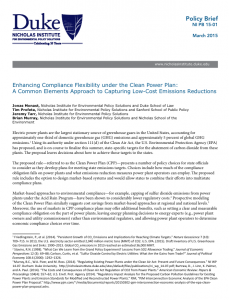Full Title: Enhancing Compliance Flexibility under the Clean Power Plan: A Common Elements Approach to Capturing Low-Cost Emissions Reductions
Author(s): Jonas Monast, Tim Profeta, Jeremy Tarr,and Brian Murray
Publisher(s): Duke University, Nicholas Institute for Environmental Policy Solutions
Publication Date: March 1, 2015
Full Text: Download Resource
Description (excerpt):
Electric power plants are the largest stationary source of greenhouse gases in the United States, accounting for approximately one-third of domestic greenhouse gas (GHG) emissions and approximately 5 percent of global GHG emissions.1 Using its authority under section 111(d) of the Clean Air Act, the U.S. Environmental Protection Agency (EPA) has proposed, and is on course to finalize this summer, state-specific targets for the abatement of carbon dioxide from these plants. The proposal leaves decisions about how to achieve those targets to the states.
The proposed rule—referred to as the Clean Power Plan (CPP)—presents a number of policy choices for state officials to consider as they develop plans for meeting state emissions targets. Choices include how much of the compliance obligation falls on power plants and what emissions reduction measures power plant operators can employ. The proposed rule includes the option to design market-based systems and would allow states to combine their efforts into multistate compliance plans.
Market-based approaches to environmental compliance—for example, capping of sulfur dioxide emissions from power plants under the Acid Rain Program—have been shown to considerably lower regulatory costs.2 Prospective modeling of the Clean Power Plan similarly suggests cost savings from market-based approaches at regional and national levels.3 Moreover, the use of markets in CPP compliance plans may offer additional benefits, such as setting a clear and measurable compliance obligation on the part of power plants, leaving energy planning decisions to energy experts (e.g., power plant owners and utility commissioners) rather than environmental regulators, and allowing power plant operators to determine economic compliance choices over time.
